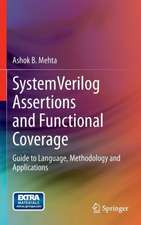Emerging Resistive Switching Memories: SpringerBriefs in Materials
Autor Jianyong Ouyangen Limba Engleză Paperback – 11 iul 2016
Din seria SpringerBriefs in Materials
-
 Preț: 315.57 lei
Preț: 315.57 lei -
 Preț: 346.86 lei
Preț: 346.86 lei -
 Preț: 343.98 lei
Preț: 343.98 lei -
 Preț: 344.90 lei
Preț: 344.90 lei -
 Preț: 357.95 lei
Preț: 357.95 lei -
 Preț: 344.90 lei
Preț: 344.90 lei -
 Preț: 344.90 lei
Preț: 344.90 lei -
 Preț: 394.82 lei
Preț: 394.82 lei -
 Preț: 375.23 lei
Preț: 375.23 lei -
 Preț: 380.63 lei
Preț: 380.63 lei -
 Preț: 374.46 lei
Preț: 374.46 lei -
 Preț: 378.92 lei
Preț: 378.92 lei -
 Preț: 378.92 lei
Preț: 378.92 lei -
 Preț: 380.07 lei
Preț: 380.07 lei -
 Preț: 377.18 lei
Preț: 377.18 lei -
 Preț: 343.98 lei
Preț: 343.98 lei -
 Preț: 344.21 lei
Preț: 344.21 lei -
 Preț: 377.18 lei
Preț: 377.18 lei -
 Preț: 376.22 lei
Preț: 376.22 lei -
 Preț: 374.85 lei
Preț: 374.85 lei -
 Preț: 412.30 lei
Preț: 412.30 lei -
 Preț: 377.18 lei
Preț: 377.18 lei -
 Preț: 376.22 lei
Preț: 376.22 lei -
 Preț: 374.08 lei
Preț: 374.08 lei -
 Preț: 445.88 lei
Preț: 445.88 lei -
 Preț: 376.80 lei
Preț: 376.80 lei -
 Preț: 385.47 lei
Preț: 385.47 lei -
 Preț: 377.35 lei
Preț: 377.35 lei -
 Preț: 377.18 lei
Preț: 377.18 lei -
 Preț: 375.45 lei
Preț: 375.45 lei -
 Preț: 377.35 lei
Preț: 377.35 lei -
 Preț: 377.73 lei
Preț: 377.73 lei -
 Preț: 380.07 lei
Preț: 380.07 lei -
 Preț: 380.07 lei
Preț: 380.07 lei -
 Preț: 378.71 lei
Preț: 378.71 lei -
 Preț: 412.30 lei
Preț: 412.30 lei -
 Preț: 380.07 lei
Preț: 380.07 lei -
 Preț: 377.18 lei
Preț: 377.18 lei -
 Preț: 378.71 lei
Preț: 378.71 lei -
 Preț: 377.57 lei
Preț: 377.57 lei -
 Preț: 377.18 lei
Preț: 377.18 lei -
 Preț: 442.24 lei
Preț: 442.24 lei -
 Preț: 378.34 lei
Preț: 378.34 lei -
 Preț: 381.00 lei
Preț: 381.00 lei -
 Preț: 373.32 lei
Preț: 373.32 lei -
 Preț: 376.22 lei
Preț: 376.22 lei -
 Preț: 377.95 lei
Preț: 377.95 lei -
 Preț: 376.80 lei
Preț: 376.80 lei -
 Preț: 376.04 lei
Preț: 376.04 lei
Preț: 377.18 lei
Nou
Puncte Express: 566
Preț estimativ în valută:
72.17€ • 75.35$ • 59.73£
72.17€ • 75.35$ • 59.73£
Carte tipărită la comandă
Livrare economică 05-19 aprilie
Preluare comenzi: 021 569.72.76
Specificații
ISBN-13: 9783319315706
ISBN-10: 3319315706
Pagini: 80
Ilustrații: VIII, 93 p. 73 illus., 41 illus. in color.
Dimensiuni: 155 x 235 x 6 mm
Greutate: 0.16 kg
Ediția:1st ed. 2016
Editura: Springer International Publishing
Colecția Springer
Seria SpringerBriefs in Materials
Locul publicării:Cham, Switzerland
ISBN-10: 3319315706
Pagini: 80
Ilustrații: VIII, 93 p. 73 illus., 41 illus. in color.
Dimensiuni: 155 x 235 x 6 mm
Greutate: 0.16 kg
Ediția:1st ed. 2016
Editura: Springer International Publishing
Colecția Springer
Seria SpringerBriefs in Materials
Locul publicării:Cham, Switzerland
Cuprins
Introduction to history of memory devices and the present memory devices.- Introduction of resistive switches memory devices with nanoparticles.- Structure, fabrication and operation of devices with a triple-layer structure sandwiched between two electrode.- Structure, fabrication and operation of devices with a single layer structure sandwiched between two electrode.- Resistive switching devices exploiting the charge transfer between metal electrode and metal nanoparticles.- Mechanisms for resistive switches.- Application of the resistive switching devices with nanoparticles.
Notă biografică
Jianyong Ouyang is an Associate Professor in the Department of Materials Science and Engineering at National University of Singapore.
Caracteristici
Details how charge trapping can occur on nanoparticles and at interface between bulk metal and metal nanoparticles Explains how charge transfer can lead to resistive switches Demonstrates how conductive filaments are formed and cause resistive switches Describe how devices with resistive switches can be used as memory devices Provides a comprehensive overview of nanoparticles, donor-acceptor materials, oxides, one- and two-dimensional nanomaterials for the fabrication and characterization of memory devices and mechanisms for resistive switches


















